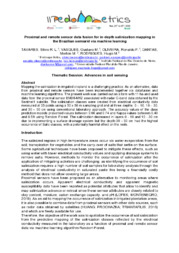Proximal and remote sensor data fusion for in-depth salinization mapping in the Brazilian semiarid via machine learning.
Proximal and remote sensor data fusion for in-depth salinization mapping in the Brazilian semiarid via machine learning.
Author(s): TAVARES, S. R. de L.; VASQUES, G. de M.; OLIVEIRA, R. P. de; DANTAS, M. M.; RODRIGUES, H. M.
Summary: Mapping the salinization in irrigated cropland is a challenging practice. As an alternative, data from proximal and remote sensors have been implemented together via datafusion and machine learning algorithms. The present work was carried out on a farm with 11 ha and used data from the proximal sensor EM38-MK2 associated with radar C-band data obtained by the Sentinel1 satellite. The salinization classes were created from electrical conductivity data measured at 35 points using a 50 x 50 m sampling grid and at three depths: 0 ? 10, 10 ? 30, and 30 ? 50 cm using conventional laboratory approach. The accuracy values of the class prediction models presented values between 0.66 and 0.74 and Kappa values between 0.43 and 0.59 using Random Forest. The salinization decreased in layers 0 - 10 and 10 - 30 cm due to implementing a surface drainage system but the depth 30 - 50 cm had the highest occurrence of Salic classes, with a potentially harmful effect on the roots.
Publication year: 2022
Types of publication: Paper in annals and proceedings
Unit: Embrapa Soils
Keywords: Remote sensing, Sensoriamento Remoto
Observation
Some of Embrapa's publications are published as ePub files. To read them, use or download one of the following free software options to your computer or mobile device. Android: Google Play Books; IOS: iBooks; Windows and Linux: Calibre.
Access other publications
Access the Agricultural Research Database (BDPA) to consult Embrapa's full library collection and records.
Visit Embrapa Bookstore to purchase books and other publications sold by Embrapa.

